
| WEAPON SYSTEMS |
This page illustrates the main weapon systems embarked on the ships of E.F.N.I., and the other EA systems that, even if are not in use in the E.F.N.I., are intresting from the technical point of view. The basic principles of some weapon families are illustrated by technical schemes.
The nominal Bore of a weapon is the
diameter of the beam/projectile/bolt ( or the dimensions of the
impact area, if this is not circular ).
The Power/energy is given in Joules (Energy) for the weapons that
operates with pulses/bolts, and it is the energy of a single
shot, while it is expressed in Watts (Power) for the weapons
operating in continuous fire mode (continuous beam).
The most powerful weapons
utilized by the Earthforce are the Earthforce Arsenals AEGIS Heavy
Particle G.O.D. cannons.
G.O.D. is the acronymous for Global
Orbital Defence,
because the first incarnations of this weapon, the Mk II and Mk III
were conceived for the Global Orbital Defence
Satellites, a powerful network of heavy satellites, placed around
the Earth, and
conceived early after the end of the Earth-Minbari War; the Mk I
was an experimental model for the cannons of the satellites, while
the MkIV, developed for the
"battlemaster project",
was the
workbench for the shipborne family, that saw the service with the
Warlock Heavy Destroyers.
The origin of the
concept is very obvious: a weapon system able to avoid another battle of the
Line. Beyond the batteries of missiles and the defensive weapons, the main
offensive arm of the large G.O.D. satellites was a weapon "able to destroy
a Sharlin
Cruiser with a single shot, at ranges exceeding the standard range of the
Minbari main beam weapons". Even if the range requirement was just
accomplished,
the Earthforce Arsenals, the "weapon arm" of the EFRAD, went well beyond the
requirements regards to the power of the weapon, as can be seen in the attached
technical Data. The G.O.D. cannon is a complex weapon, a large linear particle
accelerator fed by a battery of Synchrothrons (accumulation rings) See technical schematics .
The heavy
particles (cesium nuclei) are accumulated and accelerated in the primary
accumulation rings, until the buildup of a discharge is completed. Then the
particles of all the accumulation rings are released in a collector
an driven in
the barrell of the weapon, that is a linear accelerator able to increase the
speed/energy of the particles to relativistic levels and drive them against the
target: the concept is very classic, but the technologies employed are
very advanced, mainly in the magnetic fields generators and in the control of
the particle stream.
The early models of G.O.D. cannons had three large
accumulation rings, but the progress in the synchronization of the primary
feeders, the devices that drive the particle streams from the accumulation
rings
to the collector, enabled to build weapons with an elongated design like the Mk
V, that allowed this weapon to be installed in the hull of a ship, the Warlock
class destroyers, giving to the Earth ships a firepower never experienced
before,
and up to the long ranges. The drawbacks of the G.O.D. cannons are the
low rate of fire and the dimensions, that imposes a spinal
installation.
The accumulative working principle, yet applied in the Omega heavy
particle/pulse cannons, allows a peak power that can be enormously higher than
the average power used to feed the weapon, and is this capability to operate a
"buildup" of the discharge, in addiction to the long barrell of the second
stage accelerator, is the technology that gives to the G.O.D.
cannons their impressive destructive
power: to give an idea, can be taken as reference
the most infamous beam weapon
in standard use in an ISA Navy, the "Nur'nil'bok" ("lone sword"),
the main bow beam of the Minbari
Sharlin Warcruisers. This exceptional (and deadly) weapon has a
core diameter of 10 meters,
and a power output of more than 7300 Terawatts in continuous mode,
and this means that even the power input must be the same.
The Aegis Mk V of the Warlocks has a maximum power input of 2400 Terawatts,
about twice
a Raytheon OMEGA cannon, but a maximum discharge, with a buildup time of 30"
and a discharge time of 1", has an instantaneous power output of
75000 Terawatts:
this means that, even with a low rate of fire, the peak power on the
target is
more than ten times the power of a Sharlin, while the
enormous Mk X of the Tillmans (45 Megatons/discharge) and Mk XIII of the
Centurions (65 Megatons/discharge) are weapons with a power level close or
eventually superior respect to the weapons used by some of the First Ones ships,
like the Shadow battlecrabs (in fact the aegis Mk V has yet a peak power
that is
superior to a Shadow battlecrab beam, even if a battlecrab can shoot continuously).
This "overkill" capability has a simple consequence: there is no defence.
None of the ship of the Younger Races
can survive this power, and even many "Ancients" could find nearly
impossible to oppose
an attack brought on with a G.O.D. cannon.
Actually, the models in service are the Mk IV (G.O.D. Satellites), the Mk V (Warlock class destroyers), the Mk VI (Nike class Cruisers), the Mk IX (Nova II Dreadnoughts), the Mk X (Tillman Heavy Dreadnoughts) and the Mk XIII, the most powerful, on the Centurion Class Dreadnoughts. Actually the new batches of the Warlocks and Nikes and the next batch of the Centurions, will be equipped with the E-1 variants of the Mk V, Mk VI and Mk XIII, that incorporates a fast discharge technology (Pulse Compression) that enhances the penetrating power. (Note: The Mk VI is a lightly shortened variant of the Mk V)
The first shot in combat of the G.O.D. cannons
of a Warlock
was fired in the "Strelas'tha" incident of 2262, incidentally aginst a "rebel" Minbari Sharlin,
(see Strelas'tha incident dossier),
while the first large scale operational use of these weapons was during the
Drakh attack of 2265: the Mk III cannons of the G.O.D satellites
were capable to
nearly vanquish the attacking Drakh forces, even if this was not
enough to avoid
the spreading of the Plague nanovirus, while in that same battle,
the heavy destroyers
Warlock, Enchantress, Sorceress, Necromancer, Rhiannon, Persephone,
Titans (Navy) and Styx (EFNI)
fired their
G.O.D. cannons against the warships of the Drakh fleet: The Aegis Cannons fired 72
double discharges and 69 hit the targets, obliterating them with a single shot.
Until today, each time a G.O.D. cannon discharge has reached his target, it has
demonstrated a terminal effectiveness, with a 100% kill ratio.
TECHNICAL
DATA: Earthforce Arsenals AEGIS Mk V "Warlock" Heavy
Particle G.O.D. cannon
Designer/builder: Earthforce Arsenals .
Mode: discharges of 0.6"-1.2"
Power/Feeding requirements: 3820 Terawatts (3820e12 Watt) for the
single barrel-
Range(effective): 75,000 km
Rate of fire: Maximum, 5 discharge/minute.
Nominal bore: 6 meters (barrel bore, 9 meters)
Energy for each shot/discharge: 65,000 Terajoules (65000e12
joule, 15.5 Megatons)
Nominal piercing power, solid steel: n/d
TECHNICAL DATA: Earthforce Arsenals AEGIS Mk VI-A Heavy Particle G.O.D. cannon
Designer/builder: Earthforce Arsenals .
Mode: discharges of 0.6"-1.2"
Power/Feeding requirements: 1980 Terawatts (1980 e12 Watt) for
the single barrel-
Range(effective): 75,000 km
Rate of fire: Maximum, 4 discharge/minute, standard 2
discharge/minute
Nominal bore: 6 meters (barrel bore, 9 meters)
Energy for each shot/discharge: 51,510 Terajoules (51510e12
joule, 12.3 Megatons)
Nominal piercing power, solid steel: n/d
TECHNICAL DATA: Earthforce Arsenals AEGIS Mk XIII Heavy Particle G.O.D. cannon
Designer/builder: Earthforce Arsenals .
Mode: discharges of 1.8"-2"
Power/Feeding requirements: 12500 Terawatts (12500e12 Watt) for
the single barrel-
Range(effective): 75,000 km
Rate of fire: Maximum, 5 discharge/minute, standard 1,5
discharge/minute
Nominal bore: 12 meters (barrel bore, 20 meters)
Energy for each shot/discharge: 272,000 Terajoules (272000e12
joules, 64.8 Megatons)
Nominal piercing power, solid steel: n/d
Earthforce Arsenals Heavy Particle G.O.D. cannons - Click on the image for technical schemes.
 |
One of the newest developments in the weapon systems is the
Fusion Pulse Cannon, a weapon
outcome of the last advancements in the Gravitic enhancement of
the fusion process. The buildup of the energy of the plasma bolt
is obtained inside the barrell of the weapon, that is, by all the
points of view, the matching of a Gravitic fusion reactor and a
plasma pulse accelerator. The main advantages are the enormous
power of a bolt, the high speed and the enhanced range of the
bolt itself, and the relatively low energy consumption, while the
disadvantage of such weapons are the weight, the bulk dimensions
and the cost; the Gravitic Fusion Pulse Cannons have shown
itselves devastating at the short and medium ranges, with
terminal effects of a magnitude order highers than the ones of
the classic Pulse cannons, and an impressive rate of fire. SEE TECHNICAL
SCHEMATIC
TECHNICAL
DATA: Westhinghouse-O.T.O. Melara M381 Heavy Gravitic Fusion
Pulse cannon
Designer/builder: Westhinghouse-O.T.O. Melara .
Mode:Pulses
Power/Feeding requirements: 296 Terawatts (296 e12 Watt) - the
power output is 1150 Terawatts.
Range(effective): 1280 km
Rate of fire: Maximum, 120 pulse/minute, standard (on Centurion
Dreadnoughts) 80 pulse/minute
Nominal bore: 4*12 meters (barrel bore, 12*28 meters)
Energy for each shot/discharge: 860 Terajoules (860 e12 joules)
Nominal piercing power, solid steel: 92 meters
Westhinghouse-O.T.O. Melara M381 Heavy Gravitic Fusion Pulse cannons
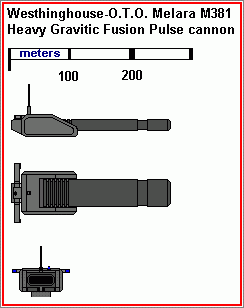 |
See technical schematics - large format |
The Hyach Spinal laser technology was acquired (salvaged) by the
E.A. shortly after the Earth-Minbari war. It still remains one of
the most powerful known raking/piercing weapons, with the
advantage of being uninterceptable, but it is very difficult to
integrate in an E.A. tech based ship, due to the power drainage
and cooling requirements. The development of pulse/particle beams
for the Omega class destroyers and of the G.O.D. particle cannon
absorbed the bulk of the E.A. weapon systems r&d
capabilities, so the reserach around the spinal laser went on
slowly, until in the late 2250, when an old but effective
principle was applied to the Spinal laser: a Q-spoiling device.
This device converted the spinal laser in a pulse weapon,
eliminating its raking capability. However, the single pulse of
the Q-spoiling spinal laser allowed it to pack the same energy of
a 6" full power discharge in a single 0.02" burst, with
a magnificent piercing power retained at the maximum range. The
weapon itself drained a lot less power in a controllable way (the
power input efffects only the rate of fire, not the power of a
single shot ), and developed less than a quarter of the waste
heat of the original type, allowing a light and sleek overall
installation. Unable to compete with the heavy particle GOD
cannon in terms of raw power, it is instead a good choice to give
a long range punch to new medium and light units, and can be
retrofitted on older ships, at a fair cost, without overwhelming
their power distribution plant.
The limit of the istantaneous power of a classic optical laser is set by the reflectivity of the two mirrors (aft and fwd) of the laser: part of the energy (light) treated by the laser is not reflected by the mirrors, but is absorbed by them; more powerful is the laser, more high is the absolute energy adsorbed by the mirrors. Above a given power level, the mirrors overheath and melt, or sublimate. The original Hyach spinal lasers, and the classic lasers used by the E.A. and by other known races used mirrors made of a tungsten alloy, with a complex cooling system. The actual Eart Alliance Q-spoiling laser utilizes mirros made of an inorganic liquid crystals polymer that has twelve times the reflectivity of the old mirrors, and twice the thermal capacity: this means that a Q-spoiling laser of actual production can manage 20-25 times the instantaneous power of the old lasers: this new technology, in conjunction with the Q-spoiling pulse compression principle, allowed to build a family of weapons with an inusitate piercing power, unmatched by any other known type of weapon of the Younger races. Obviously, this doesn't means that the Q-spoiling lasers are the definitive weapon: the high piercing power is not necessarily united with the raw destructive capability of a plasma weapon or of some types of raking weapons, like heavy particle beams or similar (*except for the A.M.S. T-1000 Q-laser of the Gladium Assault ships, whose extreme power induces different effects on the target, with high level of induced damages.).
In any case, a discharge of Q-laser is
almost always able to pierce the armor of a target, and able to
inflict heavy damage to any device or system directly on the
trajectory of the laser inside the hull. Must be added that the
actual models of Q-lasers, either the spinal and the turret
models, have a fairly high rate of fire, and so, with a sustained
ripple, are able to inflict a devastating cumulative damage. The
weapon system (General Electric GAD 16-U) of the Nike Cruisers is
based on this principle, and has proven itself extremely
effective in combat.
Actually, the "Q-Lasers" are installed in a spinal
emplacement on the Nova Delta Dreadnoughts (A.M.S. QSL -2E), on the Lupo
frigates (A.M.S. QSL - 3S) and
on the Vigilante Patrol Corvettes and are proposed for the Omega. Some turret
mounted types have been developed: the powerful A.M.S. QSL 2T
Long Lance, designed for the Tillman Dreadnoughts, the A.M.S. QSL - 4T installed on the Centurion and the Nova II Dreadnoughts and the A.M.S. QSL - 5T proposed as
a retrofit for the Nova Beta: they
have a shorter barrel, a more compact cooling system, and a power
of about 75% of the spinal models. The same cannon is available
for spinal installation on lighter ships (A.M.S. QSL - 5S).
The A.M.S. T-1000 is a special purpose
Q-spoiling Spinal Laser, whose length is about one kilometer: the
details about this weapons are classified; it was developed in
accordance with the specifications and under a contract issued by
the E.F.N.I. to satisfy the requirement for an uninterceptable
and unshieldable weapon with extreme piercing power, greater than
the ones of the Mk XIII G.O.D. cannons and of the Quantum
Discharge Weapon of the Victory Class ISA Destroyers. The only
detail that can be published is the declaration of an official
speaker of the Earth Alliance - "The T-1000 can penetrate
more than a mile of solid steel". Further details will be
published when the Joint Staffs of the Earthforce Navy will allow
the disclosure/declassification - We apologize for this necessary
censorship. - The T-1000 is the Main weapon of the Gladium
Class Heavy Assault Vectors.
TECHNICAL DATA: A.M.S QSL Q-Spoiling spinal lasers.
Q-spoiling Spinal Laser
 |
A.M.S. QSL - 2T
"Long Lance" Q-spoiling
Hard-Ray Heavy Laser.
Designer/builder:
Selenia-Marconi Systems.
Mode:Pulses of 0.02" of duration
Power/Feeding requirements: 100 Terawatts (100 e12 Watt)
Range(effective):70,000 km
Rate of fire: Maximum, 110 pulse/minute.
Nominal bore: 0.533 meters
Energy for each shot/discharge: 64 TeraJoules (64 e12 joules)
Nominal piercing power, solid steel:210 meters

A.M.S. QSL - 3S
Q-spoiling Hard-Ray Spinal Heavy Laser.
Designer/builder:
Selenia-Marconi Systems.
Mode:Pulses of 0.02" of duration
Power/Feeding requirements: 65 Terawatts (65 e12 Watt)
Range(effective):50,000 km
Rate of fire: Maximum, 120 pulse/minute maximum, standard 40
pulse/minute
Nominal bore: 0.356 meters
Energy for each shot/discharge: 31 TeraJoules (31 e12 joules)
Nominal piercing power, solid steel:180 meters
A.M.S. QSL - 4T "Equalizer" Q-spoiling Hard-Ray Heavy Laser.
 |
The General Electric Gad 16 U is a weapon that is non conventional respect to
a class of weapons, the Q-lasers, that are non conventional in
itselves.
This compact system was designed in the late 2260's taking into
account the particular needs of the Nike class
cruisers: the concept of the GAD
16 U is based upon the saturation of a target with highly
piercing laser shots: all in all, an engagement is not based upon
the power of a single discharge, but upon the cumulative effect
of many weapons firing on a same area.
At 800 shots/barrell/minute, an engagement, that usually is
1-1.2" long and carried on with three or four turrets means
that a target can find itself with an area of about 50 or 100
meters of diameter with something like 500 or 600 holes of a span
of diameter and some tenths (or hundreds) of meters deep through
hull and internal system: this has repeatedly shown to be well
enough to "sing the last song" to a Drakh cruiser.
While not used on other ships, and while being really somthing
"strange" in the weapon systems panorama, the GAD 16 U
is someway a masterpiece of optics and high technology, but there
are even the "versus" arguments: small dimensions and
light weight, high rate of fire, impressive piercing power,
awesome accuracy and reaction time, while giving the interesting
outcomes exposed above (and, BTW, the "Terminator
Cannon" is even an excellent antifighter weapon) are paid in
terms of cooling needs, maintenance, and, mostly, high costs.
In fact the whole Nike project is something ahead of the EA
standard technology, and even the exceptional combat performances
has not avoided tho the GAD 16 U and to the Nike battle cruisers
to become "special weapons" for special purposes: at
the end, a Nike costs something like 1.5 Warlock Destroyers, and
this means something.
TECHNICAL DATA: General Electric GAD 16 U
"Terminator" Q-spoiling Hard-Ray Heavy Laser.
Designer/builder: General electric.
Mode:Pulses of 0.02" of duration
Power/Feeding requirements
Feeding requirements: 65 Terawatts
Range(effective):40,000 km
Rate of fire: Maximum, 800 pulse/minute, standard (on Nike class)
760 pulse/minute
Nominal bore: 0.2 meters
Energy for each shot/discharge: 4.7 Terajoules
Nominal piercing power, solid steel:112 meters
General Electric GAD 16 U "Terminator" Q-spoiling Hard-Ray Heavy Lasers.
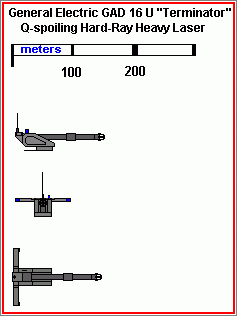 |
| BEAM /PLASMA WEAPONS |
The Beam/Pulse weapons are a family of complex, effective and versatile system that allows the use of the same barrel both as a Plasma or as a Pulse Cannon and as an heavy particle beam. This technology, exclusive of the Earth Alliance, that allows the use of a same weapon for two completely different modes, Plasma Pulses (Higher power and damage), and Particle beam pulses (Higher range) has relevant tactical advantages and has given excellent proof with many products; the dual bolt/beam technology is one of the better protected Earthforce secrets.
The pulse-particle beam cannons of the
OMEGA type are an hybrid particle beam weapon, like the Centauri
and Narn main particle beams, but in the higher range of power
output, with an added plasma bolt capability for short range
antiship warfare and, in high rate of fire pulse mode double
themselves as anti-fighter defence and as interceptors. All this
is packed in an extremely compact turrett, whose dimensions can
easily mislead the valuation of the real power of the OMEGA,
while in fact are the outcome of years of research, developement
and hard design efforts.
The OMEGA cannon is one of the most effective and powerful
weapons known:as said it can operate in plasma pulse mode (medium
rate of fire, high energy bolts), in interceptor mode (high rate
of fire, medium energy pulses) or in particle beam mode; in this
case, the emission is a beam of high energy particles (Ionized
Cesium atoms) beam, that is electrically neutralized just before
the exit from the barrell: the fire mode, in this case, can be
continuous (Raking mode), but the standard mode is a series of
discharges of 0.5-1.2 seconds of duration, that allows a peak
power double than the continuous beam emission, and that allows,
besides a raking effect, an excellent penetration.
The design of the weapon allows an instantaneous switch between
the pulse and the beam mode: at medium and short distances this
capability can be exploited in the "dual fire" : while
an high power discharge is built up in the accumulation ring, the
barrell can operate in pulse mode without interferences, and so
it is possible to fire upon a target with a continuous
bombardement of three-pulses plasma bursts immediately followed
by a beam discharge, by another pulse burst and so on: this type
of attack is something that very few targets can hope to survive
In the days of its inception and along all its service, the Raytheon OMEGA cannon gave to the Earth Destroyers a firepower that was a quantum leap respct to older designs, placing them at a level of excellence among the warships of the Younger races: the pulse mode, at short distance, allowed effects on the target that, while not exceeding the performances of the broadsides of a Nova, were anyway impressive. The heavy particle beam mode gave an unprecedented effectiveness at all the ranges, matched with an easy targeting and to a penetration on the target that is at a level on par or superior to almost all the capital ships of other alien powers, and was one of the resons that made of the Omega destroyers one of the most effective and deadly warships ever seen: the Omegas, thanks to the combination of firepower, protection, sturdiness and an overall equilibrated design, have proven themselves to be at least on the same level of the extremely advanced Drakh cruisers, superior to all the other capital ships but the Minbari, and have been a key factor in the survival of the human race and in the victory of the ISA against the Drakhs.
The SUPEROMEGA cannon is another
Masterpiece, as was at the time of his inception the OMEGA heavy
Particle/pulse cannon.
This new weapon is exactly the conceptual equivalent of the Omega
cannons, I.E. a same, compact weapon able to treat either plasma
discharges and a powerful, long ranged particle beam. Given the
success and the effectiveness and operational versatility of the
original system, the R&D team of the Raytheon Co. attempted a
further step, the matching of the Ion Bolt technology of Centauri
derivation, and the "Slicer beam" technology of the
"Shadomegas". The problem was that all the units of the
"Shadow beam" were lost, but in this occasion the
Technical Division of the EFNI was really helpful: the technical
branch of the Service was able to collect, organize and salvage a
large amount of informations, thanks to his investigations and
thanks to testimoniances and interviews with the survivors of the
"Omega-X" personnell and of the technical teams that
followed that project.
A five years research program, started in the January of 2269,
produced a compact, extremely powerful and affordable weapon of
about the same dimensions of the OMEGA cannon: the capabilities
are impressive, given the piercing and explosive power of the
large calibre Ion bolts of this new weapon, and the penetration
and raking capabilities of an high density, high amperage
antimatter beam. In the Ion pulse mode, this weapon operates in
the same way of the Ion bolt weapons (see "Ion bolt
weapons") - In the Antimatter beam mode, it operates as an
high efficience particle accelerator, as the original OMEGA
cannon, but the feeding system is totally different: instead of
the original heavy particles accumulation ring, there is a double
ring that operates in two stages: the first stage acts as an
antimatter generator, the second ring, that is the feeder of the
cannon, is an antimatter accumulation ring. The same process, in
the original shadowtech weapon, was entirely accomplished in the
barrell of the weapon, but the rate of fire was low, the barrell,
heavy and bulky, induced aiming problems and slow tracking of the
target, while the new feeding system is simpler, allows more
power and a higher rate of fire, and it's a lot more affordable
and resistant than the original coaxial feeder.
The SUPEROMEGA actually is standard issue for both the upgraded Omega Brightwarrior destroyers and for the Nova Delta Brightwarrior DN.
Some unclassified data are availble, but other data and internal
devices are highly classified, and cannot be published - We
sincerely apologize to the public for this necessary limitation.
Both the OMEGA and SUPEROMEGA are available even in a
"spinal" fixed variant, characterized by the large
magnetic deflector at the bore of the barrell, that allows the
steering of the beam and of the bolts projected in order to allow
to aim the fire against a target. This configuration is overall
equivalent to the turret variant, with some minor penalties in
the effective range and the add-on complexity of the deflector.
TECHNICAL DATA: Raytheon OMEGA Heavy Particle Beam/Plasma Pulse Cannon.
Designer/builder: Raytheon.
Mode: Particle continuous beam/Plasma Pulses.
Power/Feeding requirements: 1050 Terawatts
Range(effective): 26,000 km / 290 km
Rate of fire: Particle continuous beam/Plasma 250
pulses/barrel/minute.
Nominal bore: 4 meters / 5.5 meters (Barrel bore, 12 meters)
Power output : 1050 Terawatts (continuous beam) - 1910 Terawatts
(1" bursts)
Energy for each shot/discharge:80 Terajoule/bolt - continuous
fire @ 1050 TW, bursts @ 1910 TW.
Nominal piercing power, solid steel: 48 meters ( Continuous Beam
)*/44 meters ( plasma pulse)
*The piercing power is nominal, and related to a beam travelling across the target @ 50 meters/sec. The Raytheon Omega is a raking weapon. A particle beam travelling across the target at 25 meters/sec. can reach a nominal piercing power of about 45/50 meters of solid steel. The Raytheon OMEGA cannon is one of the most dangerous and effective weapons of the Earthforce arsenals, thanks to his power an his polyvalence: it's able to cover long range anti-ship warfare, short range anti-ship warfare, medium and short range anti-fighter warfare, Interceptor.
Raytheon OMEGA Heavy particle
beam/Pulse Cannon
 |
TECHNICAL DATA: Raytheon SUPEROMEGA Heavy Antimatter Streamer/Ion Pulse Cannon.
Designer/builder: Raytheon.
Mode: Antimatter Particle continuous beam/Ion Bolts.
Power/Feeding requirements: 1450 Terawatts
Range(effective): 38,000 km / 3700 km
Rate of fire: Antimatter continuous beam/Ion 300
pulses/barrel/minute.
Nominal bore: 3.5 meters / 5.5 meters (Barrel bore, 12 meters)
Power output (continuous beam): 1305 Terawatts (continuous beam)
- 2600 Terawatts (1" bursts)
Energy for each shot/discharge:95 Terajoule/bolt - continuous
fire @ 1300 TW - bursts @ 2600 TW.
Nominal piercing power, solid steel: CLASSIFIED ( Antimatter Beam
)*/58 meters ( Ion Bolts)
*The piercing power is nominal, and related to a beam travelling across the target @ 50 meters/sec.
Raytheon SUPEROMEGA Heavy
Antimatter Streamer/Ion Pulse Cannon.
 |
The Raytheon WI 999 is one of the two hybrid ion weapons
actually in use, the other being the Raytheon SUPEROMEGA. An
outcome of the Brightwarrior project, it was designed to give to
the Warlocks and to the Nikes the superior performances of the
Ion cannons matched with the long range of the particle beams; it
was indeed an excellent weapon, but Earthforce, with some valid
reasons, gave its preference to the MI 190 Ion Cannon, that
allowed similar performances in almost all the tactical situation
except the longer ranges, but at a vastly lower price and without
the need to replace the whole turrets. In fact, the long range
arms of both Warlocks and Nikes are the heavy particles G.O.D.
cannon, the missiles and the Starfuries, and so the beam
capability was not really needed. This accurate and powerful
weapon, anyway, due to its operational flexibility in some
particular tactical situation, has been chosen by the EFNI Naval
Service as a standard issue and it is the equipement of the E.A.S.Styx and, funding
allowing, will be eventually embarked even in the Nike cruisers
of the EFNI.
TECHNICAL DATA: Raytheon WI 999 Heavy Ion
/Particle cannon
Designer/builder: Raytheon.
Mode: High speed Ion Bolts/Particle beam pulses
Power/Feeding requirements: 345 Terawatts for the twin mount.
Range(effective): 8500 km (ion)/18000 km (Beam)
Rate of fire: Standard, Ion bolts, 55 pulse/minute/barrell / 60
discharges/minute/barrell (0,4" duration/discharge)
Nominal bore: 2 meters (Barrel bore 5 meters)
Energy for each shot/discharge: 172 Terajoules (172 e 12 joules)
pulse/120 Terajoule/discharge (beam)
Nominal piercing power, solid steel: 94 meters (ion bolts)/38
meters (beam)
Raytheon WI 999 Heavy Ion Cannon/Particle Beam
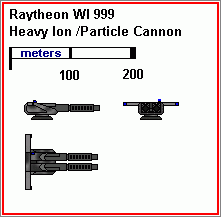 |
| LIGHT PULSE / PARTICLES
WEAPONS
INTERCEPTORS |
During all his space expantion history, the Earth Alliance Navy based his anti-fighter/anti missile defence on two main systems: the Interceptors/energy web, able to disrupt the incoming fire of Plasma bolt and particle weapons, and to intercept and destroy missiles and fighters at close range, and a powerful covering of fighters. This combination proved herself extremely effective through the Dilgar war, and in the skirmishes during the whole period until the Minbari war. During this devastating conflict, both the Nova and, in a lesser measure, the Hyperions, found themselves ill-equipped against the Nials fighters, almost always presents in numbers larger than the earther Starfuries, and qualitatively well superior to the fighters of the E.A. In many occasions, units that could survive a combat with the Minbari were destroyed by the implacable attacks of the Nials, lacking a weapon system more powerful and ranged than the interceptors, but quick and small enough to deal with the nimble and fast fighters.
The technological answer was the pulse/particle weapons, systems able to operate in dual mode, with a particle beam for the higher distance, and a fast rate of fire plasma pulse mode for the medium and short range covering. The very first of these systems was the Walther-Raytheon WR 1000, that saw the combat in the final weeks of the Earth Minbari war, and proved itself really more effective than the older systems, able, in some measure, to oppose the overwhelming superiority of the Nials.
This early weapon evolved in the more powerful Walther-Raytheon WRK 1005, that became the standard equipment of the Omega destroyers and of many more new E.A. Units, a weapon able not only to offer an extremely effective anti fighter capability, but able, at the medium to short ranges, to inflict heavy damage at larger warships. Its double pulse/particle beam mode allows a flexibility and performances unmatched by any other former design. The Walther/Raytheon WRX 1028, actually embarked mainly on the Warlock Destroyers and on the newest units, is a smaller design better suited to the anti fighter/anti missile defence, due to the higher rate of fire. Both these weapons will remain in production for long years, thanks to their effectiveness and polyvalence, and are integrated in the Interceptor Grid Mk II and Mk III.
TECHNICAL DATA: Walther-Raytheon WRK 1005 Light Particle Beam Pulse Cannon
Designer/builder: Walther/Raytheon.
Mode:Plasma Pulses/Particle Continuous beam
Power/Feeding requirements: 180 Terawatts
Range(effective):350/5500 km
Rate of fire: 380 pulse/minute/continuous beam
Nominal bore: 1.25 meters (barrel bore,3.5 meters)
Energy for each shot/discharge: 18 Terajoules (18 e12 Joule)/175
Terawatts (continuous beam)
Nominal piercing power, solid steel: 22 meters
Walther-Raytheon WRK 1005 Light Pulse Cannon
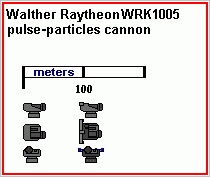 |
The Plasma cannons and the Plasma pulse cannons have been the
mainstay of the fleet arsenals from the dawn of the Earth
Alliance expansion beyond the solar system, through the
acquisition of the pulse compression technology from the Dilgars.
The Plasma weapons are a simple and effective concept: high
temperature plasma (helium collected from the fusion reactor of a
starship, but even other gases like Xenon or argon, used by
the Earth Alliance, ionised and heathed inside the barrell),
is accumulated in a containement chamber inside the
weapon. Once the necessary Plasma charge is accumulated, the
"bolt" itself is compressed, to allow the maintenance of
concentration for a given time, released in the barrell of the
weapon and accelerated by elctromagnetic fields. The energy
accumulated in a bolt is impressive, and, until the bolt begins
to decay and dissipate, it is able to inflict devastating
damages, and allows high penetrating power. The main disadvantage
of the plasma weapons are the short range and the energy and
plasma drainage from the main reactors. The great advantages are
the piercing power and the ability to release on impact a large
energy pulse, able to damage either the outer and inner
structures of a target due both the thermal-ablative effect
and to the concussive-explosive effect of the Plasma bolt:
this last effect is very important even in regards of the penetration
mechanism: when the plasma bolt impacts an armour, it vapourises the
material of the plate, and this generates even the equivalent
of a powerful explosive blast, and a shockwave through the armour.
This "explosive" effect can be powerful enough to collapse
mechanically and breach through armour and hull structure of a ship.
The EA armours are less sensitive to this effect due to the
high mechanical (and thermal) resistance of the composite materials
employed, and to the effective compartimentation of the hulls, but the
crystalline armours, while proportionally equally
or even more effectives against beam weapons, are more brittle, and much
more subject to the "concussive breaching" of the bolt weapons.
The Pulse technology is essentially a series of systems that
enhance the plasma bolt compression and shaping, giving a better
piercing power, and increasing slightly the range, and a fast
feeding system that allows to increase up to an order of magnitude
the rate of fire of a plasma based weapon.SEE TECNICAL SCHEMATICS
A classic example of heavy plasma weapon
, the LPA 1000 was the standard equipment of the Rocketdyne Nova DN of the Beta series, and was born on the guidelines of all the Nova project "...so powerful to defeat the main capital ships of the most advanced races known".Westinghouse LPA 1000 "NOVA" Heavy Plasma array
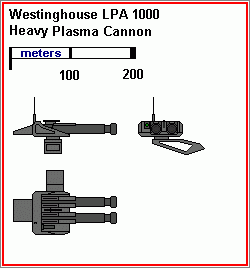 |
The M152 was a relatively light weapon
developed in the wake of the Minbari War as a new equipement for
the Hyperion cruisers.
The lack of interest of the Earthforce Navy to furtherly develop
this outdated class of warships hampered the success of an
elsewhere excellent weapon, affordable, accurate, sufficiently
powerful and both Interceptor and anti-ship capable.
TECHNICAL
DATA: M152 plasma pulse
cannon
Designer/builder: Westinghouse
Mode: Plasma Pulses.
Power/Feeding requirements: 66 Terawatts
Range(effective): 380 km
Rate of fire: Plasma 90 pulses/barrel/minute.
Nominal bore: 2.5 meters (Barrel bore, 4 meters)
Energy for each shot/discharge: 22 Terajoule/bolt
Nominal piercing power, solid steel: 19 meters.
M152 plasma pulse cannon
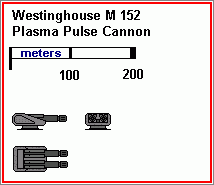 |
The HPPA Type 1505 was the first heavy plasma weapon using the
"pulse technology", and overall an effective design: a
conceptual replacement for the Novas' LPA 1000, was used only on
the Nova N's of the EFNI, while the Earthforce Navy put all its efforts
on the new Omega destroyers, and their revolutionary weapon
system.
TECHNICAL DATA: HPPA type 1505 Heavy Plasma Pulse Cannon
Designer/builder: Westinghouse
Mode: Plasma Pulses
Power/Feeding requirements: 175 Terawatts
Range(effective): 400 km/9000 km
Rate of fire: Plasma 50 pulses/minute/barrel
Nominal bore: 4.5 meters (Barrel bore, 20 meters)
Energy for each shot/discharge: 115 Terajoule/bolt
Nominal piercing power, solid steel: 55 meters (plasma)
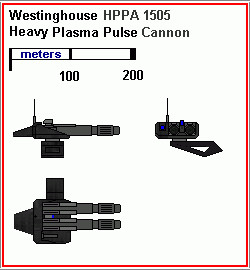 |
The HLPA 2011 is the last evolution of
the Westinghouse "1000" series heavy plasma wepons.
Large, heavy, complex, extremely powerful, it exploits the "Phased Plasma"
technology, that ensures a superior density of the plasma bolt,
with enhanced penetration and superior concussive effects.
The HLPA 2011 is one of the most
destructive weapons actually used on the EA warships, namely some
Omega Gamma and, mostly, the Nova
Delta Dreadnoughts. The HLPA
2011, during the Drakh war, has shown to be so accurate and
potent to become one of the most thrusted systems for many years
to come, and worthwile of further developments.
TECHNICAL DATA: Westinghouse HLPA 2011 Heavy Phased Plasma Array.
Designer/builder: Westinghouse.
Mode:Phased Plasma Pulses
Power/Feeding requirements: 470 Terawatts for the twin mount.
Range(effective): 540 km
Rate of fire: Standard, 60 pulses/barrel/minute
Nominal bore: 6.5 meters/5.8 meters, (barrel bore, 23 meters)
Energy for each shot/discharge: 235 Terajoules (plasma pulse)
Nominal piercing power, solid steel: 88 meters (plasma pulse)
Westinghouse HLPA 2011 Heavy Phased Plasma Cannon
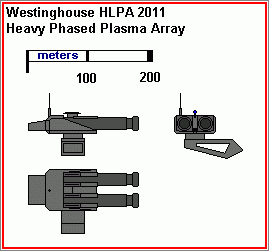 |
See technical schematics - large format |
The Westinghouse "Mjolnir" is the very first heavy plasma mortar, ancestor
of the plasma pulse mortars of the actual generation. Designed in
the late 2210's as heavy antiship weapon, it entered in service
in the 2225, with the Nova class Dreadnoughts. It is still today
used on many classes of warships from the destroyer to superior
cathegories.
The Mjolnir, even if relatively lightweight and simple, is a
large and bulky weapon, short ranged and power thirsty, that has
its best carachteristics in the high power and in the accuracy.
The rate of fire is acceptable, the piercing power is good, while
the concussive and explosive effects on the target are
impressive. Is due to its short range effectiveness that it is
still today used on large part of the ships of the fleet. Due to
the dimensions, the Mjolnir was never fitted in a turret mount:
it is installed in a fixed twin mount under the bow of the Novas
and Omegas, in a quadruple mount in the bow of the Tillman heavy Dreadnoughts,
on the sides of the bow of the Nova II, and on the
sides of the hull of the Warlock Destroyers. During the early
2250's was developed a variant of the Mjolnir, the EM2 , more
powerful and with an articulated mount, to be used as antiship
battery in fixed space installations, like shipyards, arsenals,
orbital outposts and stations.
It was the main antiship defence weapon of the M3xx series
orbital outpost core stations and of the Babylon series
diplomatic stations.
TECHNICAL DATA: Westinghouse HPM 1 Heavy
Plasma Mortar
Designer/builder: Westinghouse.
Mode:Pulses
Power/Feeding requirements: 242 Terawatts
Range(effective):180 km
Rate of fire: 50 pulse/minute
Nominal bore: 9*18 meters (barrel bore, 12*28 meters)
Energy for each shot/discharge: 290 Terajoules (290 e12 Joule)
Nominal piercing power, solid steel: 31 meters.
HPM 1 Heavy Plasma Mortar
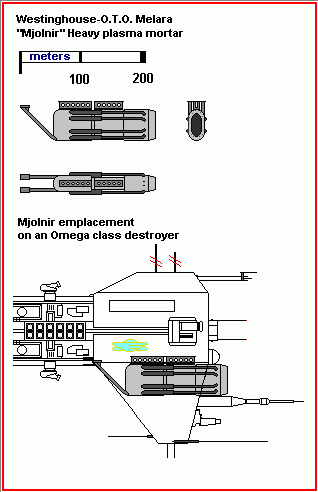 |
The actual Plasma Pulse Mortars are the last developement of the
pure plasma weapons. Employing the pulse technology and a new
"flat" barrel design that improves the penetrating
power, they are among the most effective weapons actually used on
the Earthforce units.
The most distinctive characteristics of this type of design are
the extremely high power respect to the light weight and the
simple construction, that allows high production rates, low cost
and an exceptional cost/effectiveness. Since their inception in
2268, the plasma mortars, employed both on the Lupo
Frigates (HP-01A) and on the Vigilante
Patrol Cutters (HP-08A), have
proven themselves an excellent, affordable weapon.
TECHNICAL
DATA: Westinghouse/O.T.O.Melara HP-01A Heavy Pulse Mortar
Designer/builder: Westinghouse/O.T.O.Melara.
Mode:Pulses
Power/Feeding requirements: 120 Terawatts
Range(effective):400 km
Rate of fire: Maximum, 50 pulse/minute, standard ( Lupo) 40
pulse/minute
Nominal bore: 4*12 meters (barrel bore, 12*28 meters)
Energy for each shot/discharge: 130 Terajoules ( 130 e12 Joule)
Nominal piercing power, solid steel: 44 meters
Westinghouse/O.T.O.Melara HP-01A Heavy Plasma Pulse Mortar
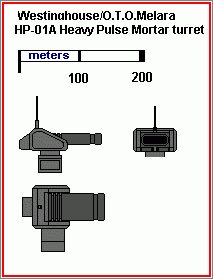 |
See Technical schematics - large format |
TECHNICAL DATA: Westinghouse/O.T.O.Melara HP-08A Pulse Mortar
Designer/builder: Westinghouse/O.T.O.Melara.
Mode:Pulses
Power/Feeding requirements: 61 Terawatts
Range(effective):380 km
Rate of fire: Maximum, 80 pulse/minute, standard 40 pulse/minute
Nominal bore: 2.5*7 meters (barrel bore, 8*18 meters)
Energy for each shot/discharge: 41 Terajoules ( 41 e12 Joule)
Nominal piercing power, solid steel: 42 meters
Westinghouse/O.T.O.Melara HP-08A Plasma Pulse Mortar
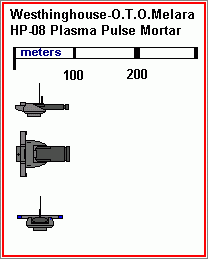 |
The Raytheon M111 was born as the standard weapon of the Warlock
destroyers, and equipped even
the Nike cruisers
and the Tillmann Dreadnoughts.
Heir of the developement work made on the OMEGA cannons and on
the HPPA type 1505, exploits totally the pulse technology, with
an high level of plasma pulse compression (Phased Pulse) that,
matching high bolt power and high rate of fire allows a superior
penetration in a compact and lightweight design. Until the
inception of the ion weapons, the M111 had very few opponents in
terms of short and medium range effectiveness.
TECHNICAL DATA: Raytheon M111 Heavy Phased Plasma Pulse cannon
Designer/builder: Raytheon.
Mode:Plasma Pulses
Power/Feeding requirements: 215 Terawatts for the twin mount.
Range(effective):600 km
Rate of fire: Standard, Plasma 80 pulse/minute/barrell
Nominal bore: 3 meters (Barrel bore 11 meters)
Energy for each shot/discharge: 85 Terajoules/bolt(85 e12 joules)
Nominal piercing power, solid steel: 65 meters
Raytheon M111 Heavy Phased Pulse Cannon
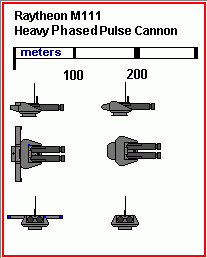 |
See schematics - large format |
The WRX 1028 is a close-in defence system, base of the Mk III
interceptor grid and an excellent antifigter/anti missile weapon.
It renounces to the polyvalence of the WRK 1005 (it has not a
particle beam capabilty) and to the power of the single shot in
exchange for an awesome rate of fire, allowed by the Gatling
design: the WRX 1028 has a six barrell bundle operating in a way
similar to the Copeland-Westinghouse GAU-112 U
"Warhammer" used on the Thunderbolt.
The rate of fire ensured by the Gatling pulse technology allows
some extreme performances, like an antifighter
"firewall" barrage mode, with area saturation patterns.
TECHNICAL DATA: Walther-Copeland WRX 1028 Light Pulse Cannon
Designer/builder: Walther-Copeland.
Mode:Plasma Pulses
Power/Feeding requirements: 25 Terawatts
Range(effective):100 km
Rate of fire: 1000 pulse/minute/continuous beam
Nominal bore: 0.3 meters (barrel bore, 0.8 meters)
Energy for each shot: 1.5 Terajoules ( 1.5 e12 Joule)
Nominal piercing power, solid steel: 6 meters
Walther-Raytheon WRX 1028 Light
Pulse Cannon
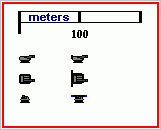 |
The mainstay of the Centauri artillery weapon systems, as well
known, are the Ion weapons. Beyond the Centauri, only the
Minbari, among the Younger races, shared the conceptual know-how
about this type of weapons, even if only the Centauri evolved
this tecnology to an unparalleled effectiveness, while the
Minbari abandoned the concept hundreds of years ago.
The Ion Cannons are the further step after the pulse/plasma
weapons: the "Ion" bolt itself is of the same physical
nature of the plasma ones, but the Centauri are able to obtain
extremely powerful and dense bolts with exceptional destructive
power, either in terms of penetration and raw energy release on
the target, and ranges well beyond the usual limits of the bolt
weapons, due to the high speed of the ion discharges that the
Centauri were able to obtain. The advantages of this type of
wepon are clear: the high penetrating power matched with the
explosive effects and the impulsive high energy release of a
powerful plasma cannon, with relatively contained power feeding,
and a range confrontable with the most common beam weapons.
Earthforce developed an interest in the Ion bolter technology
after the "Thirdspace Aliens" incident of Babylon 5:
the Heavy fighters (class "3 alpha") utilized by the
Alien race are protected by a type of "energy field/energy
shield", able to resist the fire of the plasma bolters of
the fighters, and in some degree the fire of the particle
weapons, but not sufficiently powerful to survive the fusion
pulse cannon fire of the Whitestars: in case of an engagement
with such adversaries, the antifighter weapons (WRK1005) of the
Omega destroyers and of almost all the E.A.ships could be
ineffective, while the powerful Ion weapons of the Vorchans have
power and rate of fire well in excess to destroy the Class
3-Alpha targets with a single hit. the Twin Ion array of the
Vorchans has such dimensions to barely fit on the mountings of
the WRK1005, so it would be an excellent alternative for an
upgrading of most part of the Earthforce Space Fleet.
There was an obvious problem: the Centauri, given the stressed
relations with the ISA in that period, were all but available to
give access to one of their most relevant military technology.
Even the rare relics of damaged or destroyed Centauri vessels
didn't revealed the true nature of the Ion technology, Neither to
the E.A., nor to the other members of the ISA.
In the Wake of the "Damocles" initial report about the
menace of the Thirdspace Aliens, Earthforce pushed the research
about some key technologies: in this particular area, the EFNI
was able to gather fundamental informations that allowed the
EFRAD to break the curtain of the Ion technology, and to develop
a small family of weapons with sufficient power to ensure the
single-shot kill capability against the class "3 alpha"
target for the smaller weapons, and the penetratione of the
gravitic shield of the capital ships for the larger cannons
(Raytheon M190, Raytheon SUPEROMEGA), thanks to the high energy
density and the high speed of the bolt.
The Ion Weapons technology is refined, and based upon brilliant
principles: outside the barrell, a "Ion" bolt is simply
a neutral plasma bolt, not conceptually different from the ones
of a plasma or pulse weapons, even if much more dense, powerful
and fast, but inside the weapon the processing of the bolt is
extremely different from the classic plasma weapons. First of
all, the Centauri developed a particular magneto-gravitic
containement field extremely powerful, and conceptually
assimilable to the fields of the Gravitic striction fusion
reactors and weapons, but generated by a very compact device and
with an extreme density. This allows to process a large quantity
of fully ionized heavy atoms, and to pack them in an very dense
form in the main chamber of the barrel; the bolt is easily
accelerated along the barrell of the weapons (a simple, higly
efficient LINAC), thanks to his excellent electric charge/mass
ratio, that allows high speeds in relatively short barrels. At
this point is obtained a dense, fast, extremely energized plasma
bolt, that, because of his high positive charge, would dissipate
in a few hundred meters...except for the fact that the Centauri
were able to develop a charge neutralization system that injects
a well calibrated free electron multiple stream in the muzzle of
the weapon, and neutralizes the bolt, that, from this point,
works like a normal plasma bolt. The most technologically
demanding devices of such a weapon are the
containement/compression fields, and, mainly, the neutralization
system in the muzzle of the weapons, with its fast operating and
self calibrating synchronization circuits.
The EFRAD, in conjunction with the research teams of the most
important weapons design companies, was able to develop,
validate, and produce two weapons that enable a quick and simple
(and expensive, by the way) upgrading of the antifighter defence
and of the Interceptor Grid of the Earthforce ships. The
application of the technologies developed by the Earth in his
double function weapons (particle/bolt and particle/plasma), and
in the gravitic fusion plasma cannons, allowed to quickly develop
a proprietary Ion technology.
One of the considerations that induced almost all the other ISA
members (Except obviously the Minbari) to give up about the Ion
technology research and development, was the fear for the high
energy requirements of these weapons: in fact, this is not a
correct approach. A weapon, except the internal fusion fed
weapons, has a power output directly related to the power input:
the Ion Cannons have an high energetic efficience, and the
exceptional power of the Centauri weapons is due to the large
power availability of their vessels.
Correctly, Earthforce wasn't so much concerned: the E.A. warships
are notoriously slow, but this is not due a low power
availability, it is related to the high mass of all the heavily
armored E.A. units: all the Earth warships are very heavy for
their dimensions, but with powerful engines and reactors, and a
large power availability, so they are well able to manage the
requirements of the Ion Weapons.
The actual production systems, (that have been developed as
interceptor-capable) are the Raytheon SUPEROMEGA (see chapter "BEAM /PULSE WEAPONS"), the Walther-Raytheon WRI 2028, the
substitute for the lightweight WRX1028, the Raytheon MI 190, that
is designed to fit into the barrel holders of the M111
plasma/pulse cannon turrets of the Warlocks and of the Nikes, and
the the twin barreled Westinghouse-OTO Melara WM 203 that has
been designed to be the most powerful installation compatible
with the WRK1005 emplacements of the Omegas and of the units that
actually employs this weapon. This last technical choiche was not
an accident: the WM203 is roughly equivalent to the Tavari ArmCo
VOXX twin turrett of the Centauri Vorchan: this means that, with
12 emplacements, an Omega or a Nova Delta can develop a firepower
nominally equivalent to six Vorchans: given the firarcs and the
position of the E.A. weapons, a single target will be always
subject to a firepower equal to the one of three/four Vorchans,
and this only with the secondary weapons! So, while the
antifighter/antimissile and the interceptor capability is not
only retained, but vastly improved (with some overkilling, if
this expression has some conceptual validity), the antiship
firepower is vastly improved, and made of the various units
utilizing this weapon (Omega, Nova Delta, Nova 2, Lupo) a
furtherly more dangerous challengher.
A collateral information: after the liberation of the Centauri
Republic from the Drakh infiltration, and after their rejoin of
the ISA, the Earth Alliance restarded the traditionally close and
friendly relations with the Centauri Republic.
One of the first discussions required by the Republic to clarify
the "Ion Technology situation" led to some interesting
consequences: first of all, The Earth Alliance signed a non
disclosure agreement, to keep the secrecy about this technology;
the Earthforce procurement agency paid the Royalties for the
utilization of the ion technology, and , in exchange, the House
Tavari Armament Company, builders of the Vorchan Class Warships
and traditional suppliers of the Centauri Navy, became the first
alien company to be listed in an Earth Alliance stock exchange
(HTAV.C - NASDAQ).
TECHNICAL DATA: Raytheon MI 190 Heavy Ion Cannon
Designer/builder: Raytheon.
Mode: High speed Ion Bolts
Power/Feeding requirements: 315 Terawatts for the twin mount.
Range(effective):8500 km
Rate of fire: Standard, Ion bolts, 60 pulse/minute/barrell,
(Warlock)
Nominal bore: 2 meters (Barrel bore 5 meters)
Energy for each shot/discharge: 155 Terajoules (155 e 12 joules)
Nominal piercing power, solid steel: 90 meters
Raytheon MI 190 Heavy Ion Cannon turret.
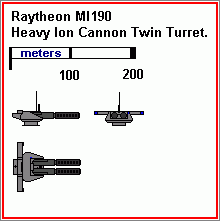 |
TECHNICAL DATA: Walther-Raytheon WRI 2028 Ion repeater.
Designer/builder: Raytheon.
Mode: High speed Ion Bolts
Power/Feeding requirements: 62 Terawatts.
Range(effective):2500 km
Rate of fire: Standard, Ion bolts, 750 pulse/minute
Nominal bore: 0.8 meters (Barrel bore 1.2 meters)
Energy for each shot/discharge: 4.8 Terajoules (4.8 e 12 joules)
Nominal piercing power, solid steel: 21 meters
Walther-Raytheon WRI 2028 Ion repeater.
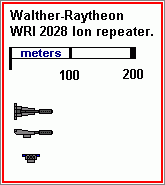 |
TECHNICAL DATA: Westinghouse-OTO Melara WM 203 Twin Ion Array.
Designer/builder: Westinghouse-OTO
Melara
Mode: High speed Ion Bolts
Power/Feeding requirements: 150 Terawatts.
Range(effective):3200 km
Rate of fire: Standard, Ion bolts, 120 pulse/minute/barrell
Nominal bore: 1.1 meters (Barrel bore 1.8 meters)
Energy for each shot/discharge: 38 Terajoules (42 e 12 joules)
Nominal piercing power, solid steel: 55 meters
Westinghouse-OTO Melara WM 203 Twin Ion Array.
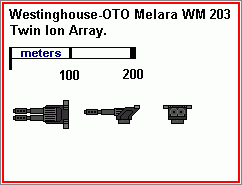 |
Railguns are potent weapons, and have been for a long time, until the Dilgar war, a masterpiece of the Earth Alliance technology. Conceptually simple, it is just a linear electric motor that accelerates a conductive projectile, it requires very good material technology to became a really operative and effective weapon. Since their inception they were well liked because of their awesome piercing power and affordability, and the ability to destroy enemy armors and systems. The railguns of the first generation were partially replaced in the favour of the Earth Alliance purchasers by the now available pulse weapons, that allowed a major theorical damage capability without ammunition supply, even with a lower piercing power. The Minbari War was an hard teacher, but in that desperate days, the Artemis Beta "Railfrigates" were among the few warships able to inflict heavy damage to the Minbari units, in the occasions when they were able to survive the firsts seconds of the battle and open fire against the enemy. The railguns of that period were low rate of fire weapons (10-25 rounds/minute), with heavy aluminium projectiles.
In the recent times, from the immediate
aftermath of the Minbari war to the developments of the mid
2250's, a new generation of railguns has started the resurrection
of this weapon system: the main differences are the projectiles,
that are no more a large aluminium slug, but a complex composite
hard core penetrator, the APHCLR shot, accelerated in a ionized
helium "bubble" wrapped around the projectile itself
that eliminates any friction between barrel/rails and projectile,
and the rate of fire that in the last products, thanks to a new
revolver feeding system and to the"frictionless"
projectile, is an awesome 2600 rounds minute for a twin mount,
with a 16000 rounds carousel magazine. The piercing power of the
small 127 mm penetrator used by the "Super Rapido"
series railguns is well enough to pierce all the known hulls,
even the ones belonging to the most advanced races, and the rate
of fire allows a devastating saturation fire.
* APHCLR=Armor Piercing sabot Hard Core Long Rod -
The actual railgun projectiles, as can be seen in the Technical Schematics, are a composite shot that has a lightweight
external frame, that is essentially the "armature" of
the impactor and its "engine" inside the barrel. The
Frame, or "Sabot", holds along its centerline a rod
made of an iridium/cobalt based alloy, extremely dense (about 20,
so 2.5 times the steel), slender and though, that represents the
85% of the mass of the projectile: at the impact the external
sabot virtually sublimates, with a relatively low penetration and
a craterization of the external face of the armor, but the
kinetic energy of the rod is so high and so concentrated on a
small area, that this inner core is virtually unstoppable.
The subcalibre principle is well known, at least as a concept,
from the mid XX century and is not strictly necessary because
even the older "solid" shots were virtually always
capable to bore through the armors of the targets, but the new
"subcalibre" scheme, while more complex and expensive,
ensures that the impactor travels well deeply through the hull,
the systems and the structures of the enemy units, and allows to
produce enormous internal damages: everything on the path of the
penetrator is destroyed, frequently along all the width of a
ship.
Oto-Melara 127mm (5") APHCLR railgun ammunition
 |
See technical schematics of railgun projectiles- large format |
The TG4 was the first "new generation" railgun,
literally built around the APHCLR ammunition of 203mm (8")
of calibre. While lacking the revolver feeding system, and using
a classic direct ramming sledge, that does not allow the superior
rate of fire of the newer models, is indeeed an effective weapon,
whose main merit is to have traced the path of new technologies
and concepts. Its fast, massive projectile has an impressive
piercing power, and the weapon is extremely accurate.
Standard equipment of the EFNI units built in the 2250's (Nova-N
and Hyperion-N), has proven its effeectiveness in many occasions,
even during the Drakh war. Was a TG4 of the Nova Dreadnought
E.A.S.Talos of the EFNI Naval Service to defeat a Shadow
"battlecrab" during the fighting ensued in the Bright Eagle
mission.
TECHNICAL DATA: 203/400 TG4 Heavy railgun
Designer/builder: O.T.O.Melara.
Mode:Single shots, free bursts.
Power/Feeding requirements: 3.2 Terawatts for the twin mount @
240 Rounds/minute.
Range(effective):400 km
Rate of fire: 120 rounds/minute/barrell
Nominal bore: 203 millimeters (8")
Energy for each shot: 0.8 Terajoules
Muzzle speed: 41500 meters second
Nominal piercing power, solid steel: 90 meters
O.T.O.Melara 203/400 TG4 railgun.
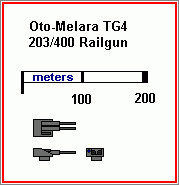 |
The 127mm (5") railguns were a lucky development aimed to
allow a superior antiship effectivenes to medium warships against
well armoured but highly manoeuverable targets. Indeed, even if
relatively small, the lightweight and elongated 127mm APHCLR
projectile has a terrific piercing power, and this series of
railguns is the first to use the "revolver" feeding
principle, that allows a rate of fire of more than 1200 shots
minute (20 shots each second) for each barrell.
Largely employed on the Lupo Frigates and Nike Cruisers, but
embarked even on ships of the dreadnought/destroyer class, the
matching of high penetration, accuracy and high rate of fire
makes of these railguns a devastating short range weapon.
TECHNICAL DATA: O.T.O.Melara 127/748 Compatto and Super Rapido and 127/762 Super Rapido 2 railgun
Designer/builder: O.T.O.Melara.
Mode:Single shots, 25 shots bursts, free bursts.
Power/Feeding requirements: 2,9 Terawatts for the twin mount @
2600 Rounds/minute.
Range(effective):700 km
Rate of fire: 127/748 Compatto: 450 rounds/minute/barrell,127/748
and 127/762 Super Rapido: 1300 rounds/minute/barrell
Nominal bore: 127 millimeters (5")
Energy for each shot: 65 Gigagajoules
Muzzle speed: 81000 (127/748) - 86000 (127/762) meters/sec.
Nominal piercing power, solid steel: 80 meters
O.T.O.Melara 127/748 Compatto and Super Rapido and 127/762 Super Rapido 2 railgun turrets.
 |
See technical schematics - large format |
The "Vulcano" 406/240, usually installed on the Warlocks, sacrifies partially the rate of fire, that is a still impressive 600 shots/minute for the double turret with an 8000 rounds carousel magazine, to enable the use of a larger, heavyer projectile, even this of the APHCLR* type and popularly nicknamed the "Silver Bullet", that allows awesome penetration and a superior damage potential. The 406/240 was the first weapon of the new family, dated back to the 2254, and was specifically designed to smash through the hull of a Minbari Shargoti cruiser from side to side.
TECHNICAL DATA: 406/240 "Vulcano" Heavy railgun
Designer/builder: O.T.O.Melara.
Mode:Single shots, 5 shots bursts, free bursts.
Power/Feeding requirements: 32 Terawatts for the twin mount @ 600
Rounds/minute.
Range(effective):600 km
Rate of fire: 300 rounds/minute/barrell
Nominal bore: 406 millimeters (16")
Energy for each shot/discharge: 3,1 Terajoules
Muzzle speed: 62000 meters second
Nominal piercing power, solid steel: 125 meters
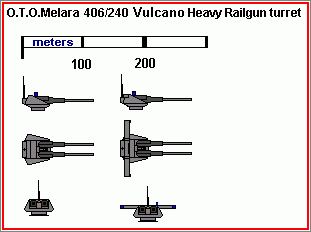 |
For all its history, from the beginning
of the space combat until the present days, Earthforce has always
had an articulated inventory of missiles, that can be divided in
two main breeds: the endoatmospheric missiles, mainly tactical
weapons, anti-aircraft (either air to air and surface to air), or
ground attack weapons (air to ground and ground to ground), and
the exoatmospheric missiles, that were subdivided in
antifighter/antimissile, bombardement and antiship roles. The
endoatmospheric missiles are out of the objectives of this
paragraph, that instead presents the last evolutions in the
exoatmospheric antiship missiles.
Missiles are not equally used by the space fairing races:
Earthforce, Centauri and Drazi Navies all uses at least one type
of missile, if not more, while Minbari, Narn, Vree and Brakiri
don't believe in this type of weapon: Minbari and Vree relate on
their technologycal edge in the areas of propulsion, weapons and
electronic warfare, and the Narns, having their historical enemy
in the Centauri Republic, have not been able to develop guidance
systems unjammable by the advanced Centauri electronic
countermeasures.
Antiship and antifighter missiles were an important part of
Earthforce weapon systems until the Dilgar war: the tecnologycal
superiority of the Dilgars was not enough to render uneffective
Earthforce missiles launched in swarms, but was enough to proof
these old generation weapons not so effective, respect to the
combination of heavy plasma artillery and Starfury fighters.
The lack of cost/effectiveness during this war, in combination
with the efforts in development of the new generation Plasma
Pulse Weapons, brought a lack of interest in the evolution of old
weapon systems: Missiles and railguns were the victims of the
budget relocations, and Earth Alliance faced the Minbari with
missile systems of a generation dated before the Dilgar war, and
based on active radar homing+direct data link guidance
principles: obviously, they were almost useless against the
Minbari. The only hit of a missile warhead during the Minbari war
was achieved by warheads removed from the missiles, and used as
hand-laid mines in the Asteriod belt to destroy the Drala-Fi
(Shargoti class battlecruiser).
A more realistic approach to the missile
utilization followed the war, and started from some fundamental
assessments:
1-The basic radar homing guidance principle
alone is effective only against less technologically advanced
foes: new (or old, but different) guidance principles must be
used.
2-There is not a technology able to obtain the
optical and infrared invisibility.
3-A thermonuclear warhead is effective against
an heavily armored ship (particularly if equipped with refractive
crystalline armor) only with a direct impact or with a very close
range detonation. In this case, the ship is or destroyed or
crippled.
4-A Starfury, with a maeneuvered approach
trajectory, can close the distances until to the physical contact
with almost anythting, if it's able to avoid the pursuit of enemy
fighters. Consequence: a saturation swarm attack of very
maneuverable and very fast medium range missile, should be able
to avoid partially enemy fighters pursuit and to survive CIWS
fire long enough to insure a very probable direct hit.
From these statements were devloped some new families of
missiles: the most important of them are the Rayhtheon "Blue
Phoenix" polyvalent heavy missile, the Sandia
"Shillelagh" antiship missile and the A.M.S.
"Viper" missiles. The most important difference between
these weapons is that the Shillelagh and the Viper are single
warhead missiles (the shillelagh is a medium sized shipborne
missile, while the Viper is a relatively small missile utilized
by the Starfury fighters of the Aurora SA-23-G, Badger, SA-26-A
Thunderbolt, and SA-32-A Firebolt models), while the "Blue
Phoenix" is a very large missile, equipped, in his antiship
variant, with seven independent terminal attack vehicles, that
are, from all the viewpoints, smaller missiles with high speed
and extreme maneuverability. The first operational destination of
these missiles was the Global Orbital Defence Satellite grid: The
G.O.D. sats have a large number of launch silos for these
missiles, intended for saturation "swarm" attacks, and
the missiles itselves are equipped with a totally redundant
guidance and homing system, that, while retaining an improved
radar homing system, is centered upon an array of optical
sensors, operating either in the visible light, ultraviolet and
Infrared bands, with advanced image recognition and data fusion
systems and algorithms, that render very impervious to the
jamming/cloaking the guidance system. Both the Shillelagh, the
Viper, and the "Barracuda" terminal attack vehicles of
the Blue Phoenix are equipped with plasma thrusters that enable
quick random maneuvres to dodge the antimissile weapons fire, and
an exceptional maneuverability. The propulsion systems of these
medium and short range missiles are centered upon high thrust,
short endurance Ion engines, ables to achieve accelerations of 70
to 850 "g's" for a few minutes*.
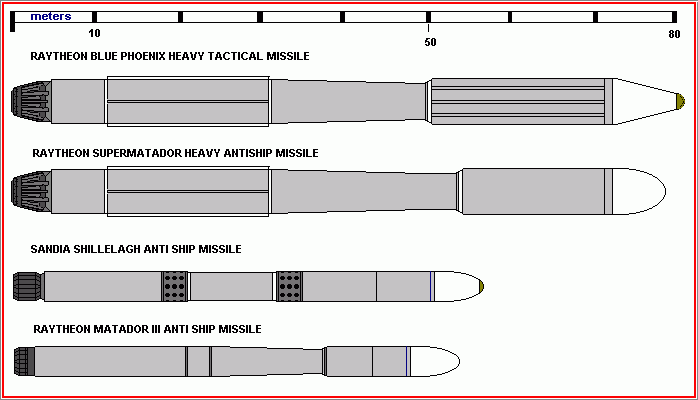 |
See technical schematics - large format |
Operational use
Operationally, the first use of these missiles was during the
Battle for the Earth, when the Earth Liberation Forces faced the
Clark's Regime, and were fought by the missiles of the G.O.D.
Satellites. The ripples of missiles, even if destroyed in the
percentage of 70/75% by the Starfuries, the Whitestars and the
Nials, and furtherly intercepted by the close-in weapons of the
Liberation Fleet, were able to get many direct hits against the
ships, included seven direct hits against the Sharlin Cruisers
that supported the Earth Fleet: none of the warheads detonated,
avoiding further losses of human lives, because the arming codes
of the thermonuclear warheads were altered and disabled by a
loyal intrusion agent of the E.F.N.I.
The first ship class to employ these new, effective missiles, in
an installation able to insure a saturation attack, was the
Warlock destroyer, with his 12 "Blue Phoenix" and 16
"Shillelagh" launching silos. The first use of this
weapon was in the "Strelas'tha"
incident , when the
second of the three rebel Minbari cruisers belonging to the
"Tragati Fleet" met his destiny, trying to ambush the
Warlock Destroyer "Sorceres" on border patrol duty: the
Minbari ship hit first, but the special armor of the Warlock
contained the damage, and the E.A. unit was able to reply to the
fire with the railguns, and a ripple of the Warlock's missiles,
and in this occasion the warheads were armed: one
"Shillelagh" missile and at least four
"Barracuda" terminal Vectors achieved a close
detonation, incapacitating the minbari Cruiser that was destroyed
by a G.O.D. cannon discharge. Historically, and laying a curtain
of discreption about the politic wake of the incident, this was
the first time an Earth Force Warship survived an One-to-one,
open space engagement with a Minbari unit, and, furthermore, won
the fight, even if damaged.
The missile systems of the Warlocks in the evolved variants Block
IV-A and Block VIA and -Doperated with all their devastating
power against the Drakhs, in the "Second Line Battle"
of 2266, and were instrumental in the destruction of the Drakh
warfleet.
*The Viper has a solid propellant, Magnetoplasmadynamic engine,
simpler and smaller than the Ion engines of the larger missiles.


